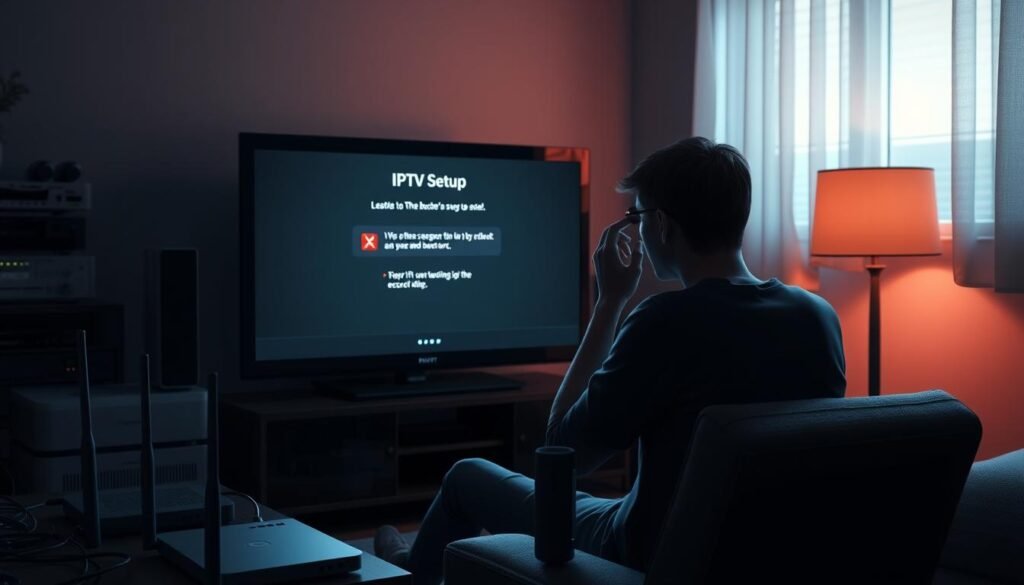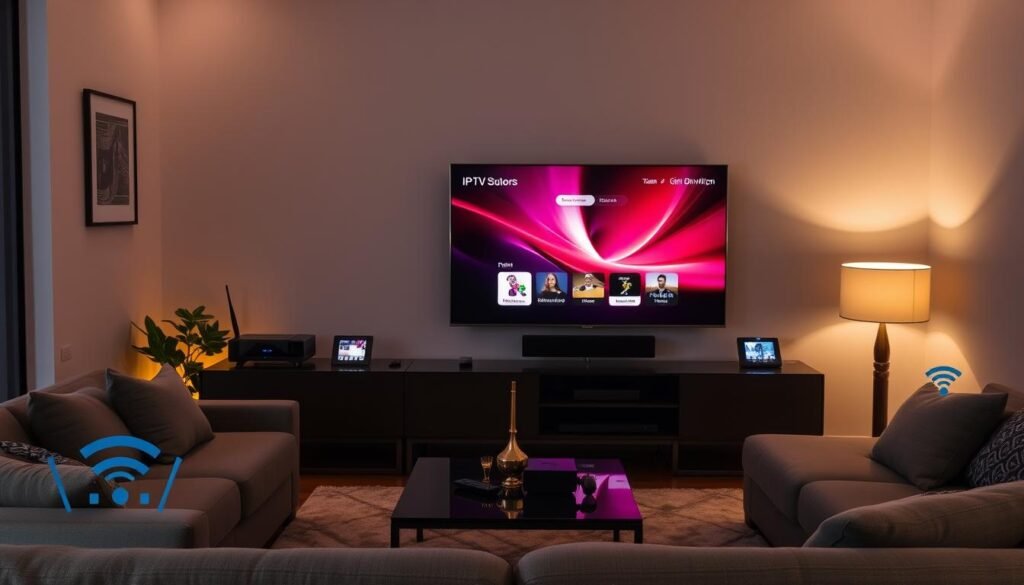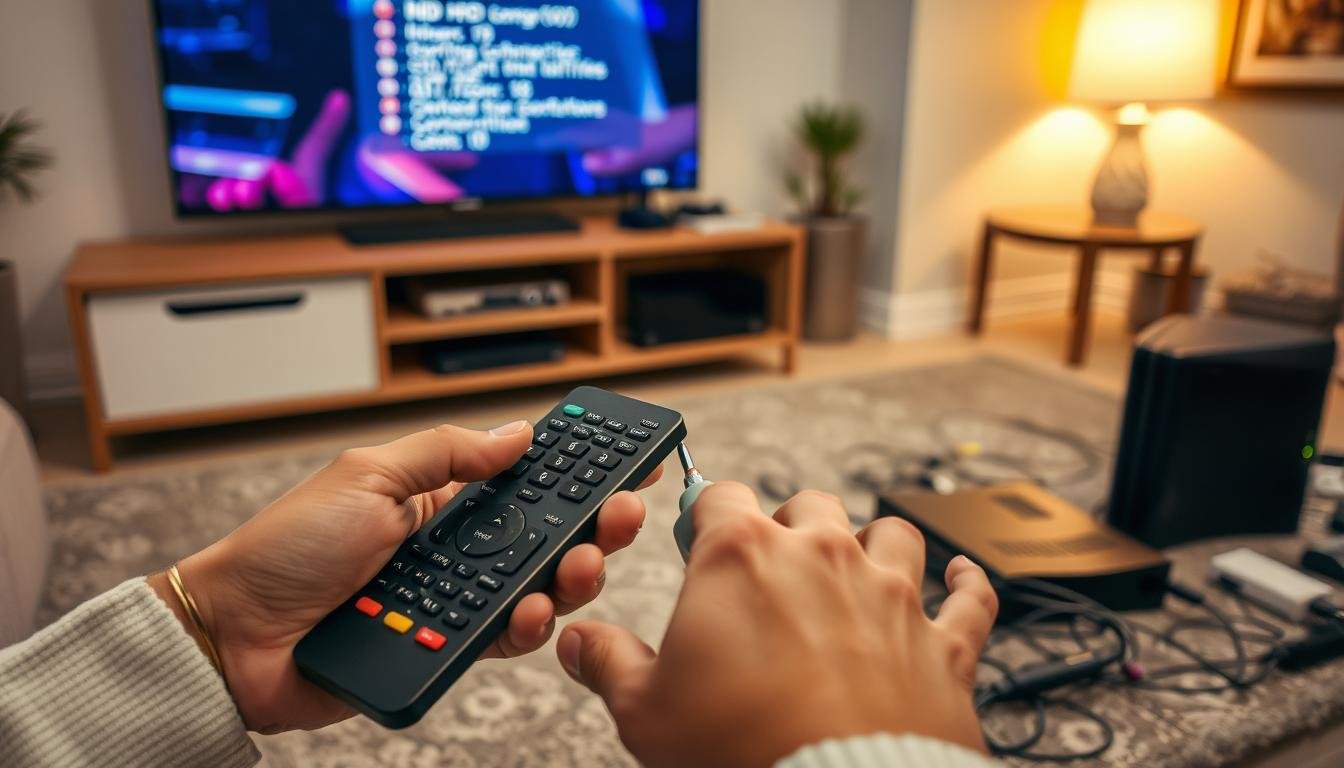IPTV (Internet Protocol Television) is now a top choice for watching TV online. It offers flexibility and convenience. But, like any tech, IPTV users sometimes face problems. This guide will help you fix common IPTV issues, so you can enjoy smooth streaming without interruptions.
Key Takeaways
- Understand common IPTV issues, such as buffering, authentication failures, and connectivity problems.
- Learn effective troubleshooting techniques to address IPTV performance and streaming quality issues.
- Discover how to optimise IPTV server connectivity and enhance simultaneous stream capabilities.
- Explore solutions for resolving set-top box hardware and firmware-related problems.
- Familiarise yourself with managing IPTV parental controls to ensure a safe viewing environment.
Understanding Common IPTV Issues
IPTV users in the UK often face technical problems that ruin their streaming. Issues like buffering, authentication failures, and poor streaming quality are common. Knowing the symptoms and causes helps users fix these problems, making IPTV viewing better.
Identifying Symptoms of IPTV Problems
First, it’s key to spot the signs of IPTV trouble. Look out for:
- Frequent buffering or lag during playback
- Sudden interruptions or disconnections in the IPTV service
- Difficulties logging in or authenticating the IPTV subscription
- Reduced streaming quality, such as pixelation or low resolution
- Hardware compatibility issues with the set-top box or other IPTV devices
Common Causes of IPTV Disruptions
After spotting the symptoms, it’s crucial to find the causes. Common problems include:
- Network connectivity problems: Slow internet, router issues, or network congestion can affect IPTV server connectivity and streaming quality.
- Subscription issues: Wrong login details, expired subscriptions, or account problems can cause authentication failures.
- Hardware compatibility: Old or incompatible devices can lead to playback issues and limited functionality.
- Content licensing and rights: Restrictions on content can cause regional blackouts or make content unavailable.
Understanding symptoms and causes helps users tackle IPTV problems better. This improves their IPTV streaming quality and overall viewing experience.
Troubleshooting IPTV Buffering Problems
Buffering problems in IPTV can be really frustrating. It causes delays and interruptions in video playback. This issue can stem from many factors, like network congestion or bandwidth limits. We’ll look at common causes and how to fix them for better streaming.
First, find out what’s causing the buffering. Slow internet is often the problem. It doesn’t have enough bandwidth for good streaming. Server overload is another issue, especially when many users are online at once.
To solve buffering, check your internet speed. Use a speed test to see if your plan is working. If not, think about getting a faster plan. You could also try a VPN to get around network issues.
| Potential Causes of IPTV Buffering | Recommended Solutions |
|---|---|
| Slow or unstable internet connection | Check internet speed, consider upgrading plan, or use a VPN |
| Server overload and high user demand | Contact your IPTV provider for assistance |
| Hardware or software issues with your IPTV device | Troubleshoot device, update firmware, or replace if necessary |
If buffering still happens, it might be your device or software. Make sure your device is updated. If it’s old or broken, you might need to get a new one.
By fixing the root causes of IPTV buffering problems, you can improve your streaming quality. This will make watching videos much smoother.
Resolving IPTV Authentication Failures
Dealing with IPTV authentication failures can be really frustrating. It stops you from watching your favourite shows and movies. But, there are ways to fix these problems.
Verifying Subscription Details
Start by checking your subscription details. Make sure your IPTV subscription is active and you have the right login info. Contact your IPTV provider to check your account status and get new login details if needed.
Resetting Login Credentials
If your subscription is okay but you still can’t log in, try resetting your login. You might need to ask your IPTV provider for a password reset or update your login info yourself. Make sure to follow their instructions well to get back into your IPTV service.
| Common IPTV Authentication Issues | Potential Solutions |
|---|---|
| Expired or invalid subscription | Renew or update subscription details |
| Incorrect login credentials | Reset login credentials |
| Multiple device logins exceeding limit | Manage device connections or upgrade subscription |
| Geographical restrictions | Use a VPN or contact IPTV provider for assistance |
By trying these steps, you can solve IPTV authentication failures. This way, you can keep watching your favourite shows and movies without any trouble.

Optimising IPTV Server Connectivity
For a smooth IPTV streaming experience, reliable server connectivity is key. It’s important to focus on internet speed and network settings. We’ll look at ways to boost your IPTV server connection and keep streaming quality high.
Checking Internet Connection Speed
Start by checking your internet speed. A slow or unstable connection can cause IPTV buffering and interruptions. Regular speed tests will show your download and upload speeds. Compare these to the IPTV service’s requirements.
If your speeds are too low, think about upgrading your broadband. Or, check with your internet service provider for any issues.
Adjusting Network Settings
Good network settings also play a big role in IPTV connectivity. Make sure your router and devices are set up for IPTV streaming. Adjust settings like:
- Prioritising IPTV traffic with Quality of Service (QoS)
- Configuring port forwarding for IPTV traffic
- Keeping your router and devices’ firmware up to date
- Reducing wireless interference from other devices
These tweaks can help your IPTV service get the bandwidth it needs. This ensures smooth, high-qualitystreaming quality.
| IPTV Server Connectivity Checklist | Recommended Actions |
|---|---|
| Internet Connection Speed | Conduct regular speed tests and upgrade to a higher-speed broadband plan if necessary |
| Network Settings | Optimise QoS, port forwarding, firmware updates, and wireless interference |
| IPTV server connectivity | Ensure reliable and stable connection to maintain streaming quality |

“Reliable IPTV server connectivity is the foundation for a seamless and uninterrupted IPTV experience.”
Enhancing IPTV Streaming Quality
Keeping viewers happy with IPTV streaming is key. But, poor video and audio can cause issues like pixelated images and audio sync problems. Luckily, there are ways to improve your IPTV service’s streaming quality.
Adjusting Video Bitrate Settings
The video bitrate greatly affects IPTV streaming quality. A higher bitrate means better image quality but uses more bandwidth. Try different bitrates to find the right balance for your system.
Optimising Network Configurations
A stable network is vital for top-notch IPTV streaming. Make sure your internet speed is good. If not, consider a faster plan. Also, tweak your router settings and avoid heavy internet use when streaming.
Advanced Troubleshooting Techniques
For tough streaming quality problems, advanced troubleshooting might be needed. This could involve checking network traffic, looking for hardware issues, or getting help from your IPTV provider.
| Factors Affecting IPTV Streaming Quality | Recommended Actions |
|---|---|
| Video Bitrate | Adjust bitrate settings to find the optimal balance between quality and bandwidth usage |
| Network Connectivity | Ensure a stable and reliable internet connection, optimise network settings, and consider upgrading broadband plan if necessary |
| Hardware Limitations | Identify and address any hardware-related bottlenecks that may be impacting streaming quality |
By using these strategies, you can greatly improve IPTV streaming quality. This will make your viewers’ experience better and more enjoyable.

Managing IPTV Parental Controls
IPTV services have parental control features to block unsuitable content. We’ll look at how to set up and manage these controls. This ensures your family can watch IPTV safely and responsibly.
Setting Up Parental Control Preferences
Most IPTV platforms have detailed parental control options. Here’s how to set them up:
- Log into your IPTV account and find the parental control settings.
- Create user profiles for each family member, setting age ratings and content limits.
- Use a PIN or password to lock the parental control settings from changes.
- Look at the content filtering options, like blocking channels or genres.
- Adjust the settings to match your family’s values and age limits.
Restricting Access to Inappropriate Content
Strong parental controls ensure your family watches age-appropriate content. This includes:
- Blocking channels or programmes with adult content, like violence or mature language.
- Setting limits on viewing time or restricting access during certain hours, like school or bedtime.
- Stopping in-app purchases or premium content access without your okay.
- Keeping an eye on what your kids watch to make sure they follow the rules.
Being proactive with IPTV parental controls makes for a safer and more fun viewing experience for everyone.
Resolving common IPTV issues with Set-Top Boxes
Set-top boxes are key to enjoying IPTV. But, sometimes, they can have problems. This might be due to hardware issues or outdated firmware. We’ll look at common problems and how to fix them to get your IPTV working smoothly again.
Troubleshooting Hardware Issues
Hardware problems with IPTV set-top boxes can show up in different ways. For example, the device might not turn on, the remote might not work, or HDMI connections could be faulty. Here are some steps to help you fix these issues:
- First, check the power supply and connections. Make sure the set-top box is plugged in right and the power cable is not damaged.
- Then, look at the HDMI cable. Make sure it’s connected well to both the set-top box and your TV. Try a different HDMI port or cable if you can.
- Next, test the remote control. Change the batteries and make sure it’s paired with the set-top box correctly.
- If none of these steps work, you might need to do a hard reset. Press and hold the reset button on the set-top box for a few seconds.
Updating Set-Top Box Firmware
Old firmware can cause problems like slow performance, connection issues, or compatibility problems. To keep your set-top box running smoothly, follow these steps:
- First, check the manufacturer’s website for the latest firmware updates.
- Then, download the right firmware file for your set-top box model.
- Follow the instructions to update the firmware. This usually means connecting the set-top box to the Internet and starting the update.
- After updating, restart the set-top box. Check if the problem is fixed.
By fixing hardware problems and keeping your IPTV set-top box firmware updated, you can improve your viewing experience. This will help avoid any interruptions to your entertainment.
Maximising Simultaneous IPTV Streams
IPTV services let you watch different shows on various devices at home. To do this, you need to know how much bandwidth you have. Also, setting up quality of service (QoS) settings helps ensure your IPTV works well with many streams.
Identifying Bandwidth Requirements
The number of IPTV streams you can watch at once depends on your internet speed. Think about the video quality and how many devices you’re using. Better video quality and more devices mean you need more bandwidth for a smooth watch.
Configuring Quality of Service Settings
To watch more IPTV streams at once, tweak your network’s QoS settings. QoS makes sure IPTV gets enough bandwidth for top-notch streaming. By adjusting these settings, you can give your IPTV more bandwidth, even when other internet activities are happening.

